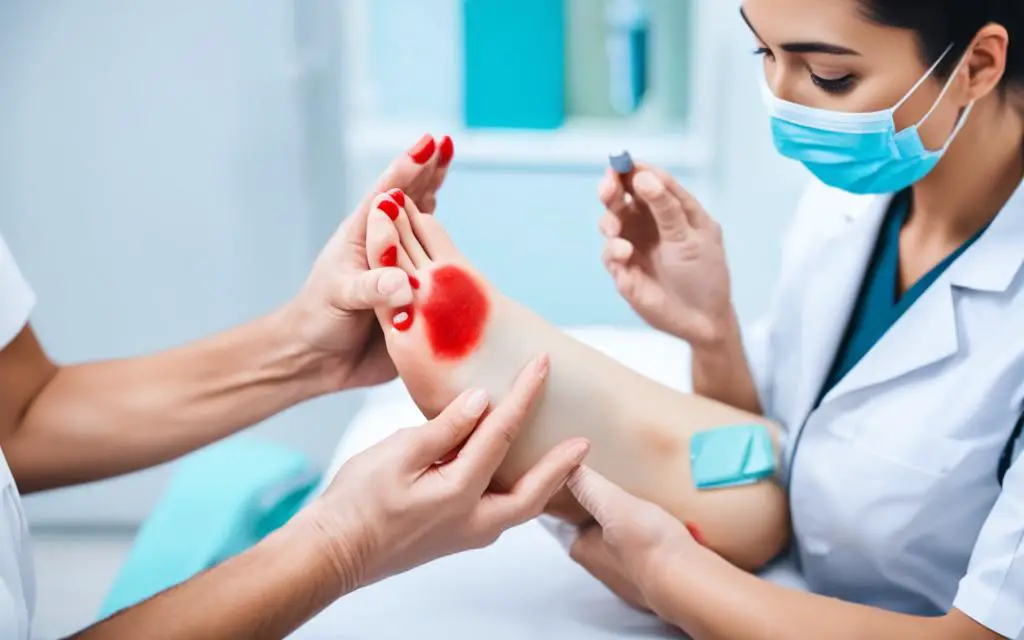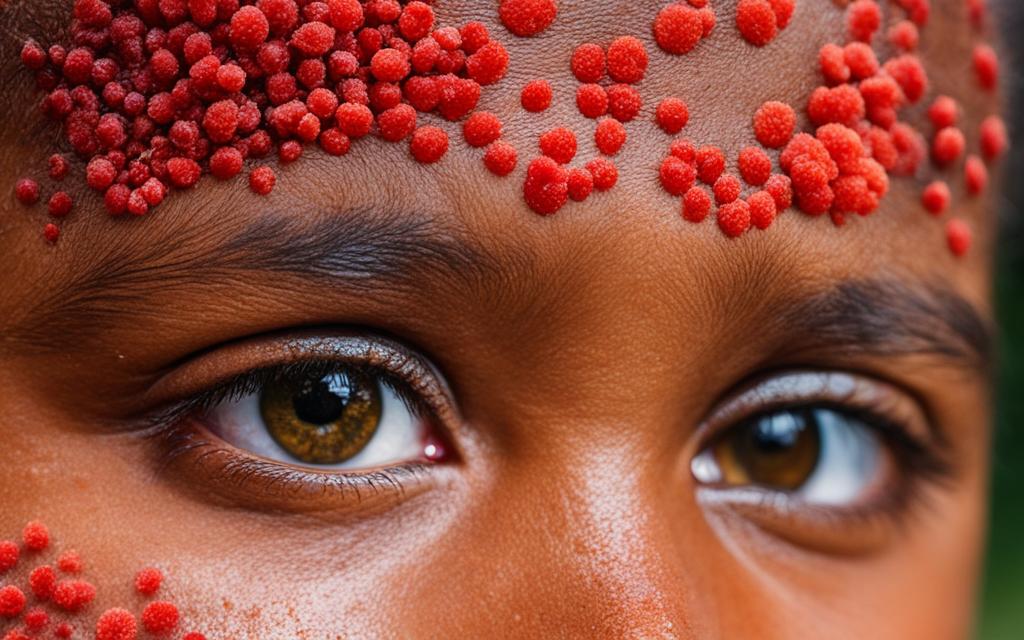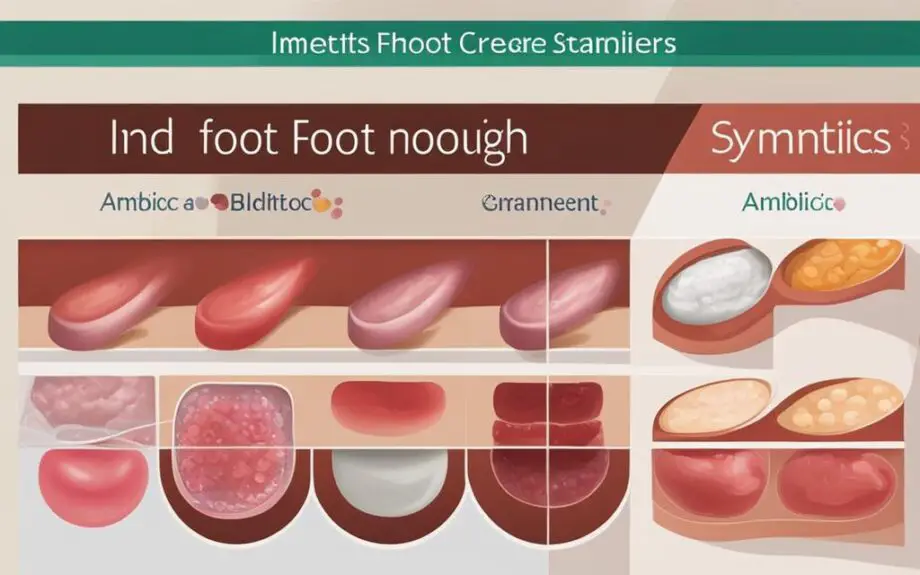When it comes to common skin infections in children, impetigo and hand foot mouth disease are two conditions that parents should be aware of. These infections can have similar symptoms, but it is crucial to identify the differences between them to provide the best care for your child.
In this article, we will provide an overview of impetigo and hand foot mouth, highlighting their unique symptoms and the best care practices for each condition. We’ll also dive into the causes and available treatments for both conditions to help parents understand how to prevent and treat these infections.
Key Takeaways:
- Impetigo and hand foot mouth are two common childhood infections.
- Although they can have similar symptoms, they are caused by different pathogens.
- Identifying the specific symptoms of each infection can help parents determine which condition their child has and how to provide proper care.
- There are various treatment options available for both impetigo and hand foot mouth.
- Parents should seek medical advice if their child’s symptoms persist or worsen.
Understanding Impetigo
Impetigo is a common bacterial infection of the skin that typically affects children between ages 2 and 6, although it can appear in people of any age. The infection usually starts with a red sore, which then ruptures and oozes fluid, forming honey-colored crusts. The condition is highly contagious, spreading easily through direct contact or through sharing of personal items such as towels and clothing.
Impetigo Symptoms: Symptoms of impetigo include the development of red sores which rupture easily and ooze fluid, leaving behind honey-colored crusts. Affected areas may also be itchy and painful. Impetigo pictures can help with identification of the infection.
Impetigo Causes: Impetigo is caused by two types of bacteria: Staphylococcus aureus and Streptococcus pyogenes. The bacteria enter the skin through cuts, scrapes, bites, or other breaks in the skin’s surface.
Impetigo Treatment: Mild cases of impetigo may clear up on their own without treatment, but treatment options include antibiotics, both topical and oral. You should always consult a doctor when you suspect impetigo or notice any symptoms. The use of impetigo pictures may help identify its severity and direct proper treatment.
Getting to Know Hand Foot Mouth
Hand Foot Mouth disease, commonly known as HFMD, is a viral infection commonly found in children below five years old, although it can affect older people as well. The disease is caused by Enterovirus and normally begins with a fever, sore throat, and loss of appetite. This is followed by the development of a distinct rash that appears on the palms of the hands, soles of the feet, and the back of the mouth. The rash can also appear on the buttock or genital areas in some cases. Children often experience a decreased appetite and may become irritable.
HFMD is typically spread when an infected individual coughs or sneezes, or through contact with the stool. Poor hygiene is also a known cause of the disease, thus it is crucial to practice regular hand washing and maintain good hygiene to prevent the spread of the virus.
| Symptoms | Causes | Treatment | |
|---|---|---|---|
| Common | Fever, Sore throat, Rash on palms and soles of the feet, Blisters in the mouth and throat, Irritability, Decreased appetite | Enterovirus, spread through coughing, sneezing, contact with stool or poor hygiene | No specific treatment, self-care measures such as rest, fluids, and pain relief medication |
Unfortunately, there is no specific treatment for HFMD, and symptoms can last up to ten days. However, self-care measures such as rest, fluids, and pain relief medication can help ease the symptoms. If you experience severe symptoms or the symptoms persist for a long time, it is advisable to consult a doctor for further medical attention.

Spotting the Symptoms
Impetigo and hand foot mouth share some similar symptoms, but there are also some distinct differences between the two. It is essential to be able to spot these differences to ensure you receive the proper care.
Impetigo Symptoms
The first symptoms of impetigo often appear around the nose and mouth and tend to spread to other areas of the face and body. They include:
- Red sores that quickly burst, leaving behind yellow crusts or scabs
- Itching and burning on and around the affected area
- Fluid-filled blisters that break easily and spread to other areas
If left untreated, impetigo may lead to further complications such as cellulitis or kidney inflammation.

Hand Foot Mouth Symptoms
Hand foot mouth is a viral infection commonly contracted by young children. Symptoms typically appear three to seven days after exposure and can include:
- Fever and headache
- Sore throat and mouth ulcers
- Rash or blisters on the hands, feet, and mouth
- Lack of appetite
If your child presents these symptoms, it is essential to seek medical care and monitor them closely as complications such as dehydration may follow.

Understanding the Causes
Impetigo and hand foot mouth are both contagious conditions caused by different viruses and bacteria.
The most common causes of impetigo are the bacteria Staphylococcus aureus and Streptococcus pyogenes, which can enter the body through breaks in the skin. These breaks can result from insect bites, scratches, or cuts, as well as from pre-existing skin conditions like eczema.
Hand foot mouth, on the other hand, is caused by the coxsackievirus, which spreads through direct contact with contaminated respiratory or fecal matter. This makes children, particularly those in daycare or school settings, more susceptible to the condition.
Knowing the causes of these conditions can help individuals take preventative measures to avoid contracting them. Proper hygiene practices, such as washing hands regularly and avoiding close contact with infected individuals, can also help reduce the risk of these conditions.
Effective Treatment Options
When it comes to treating impetigo and hand foot mouth, there are several options available. The treatment approach will depend on the severity of the symptoms and the underlying cause of the condition. In some cases, self-care practices can be utilized, while medical interventions may be necessary for more severe cases.
Impetigo Treatment
If you have impetigo, it’s important to keep the affected area clean and dry. Your doctor may recommend using antibiotic ointments or oral antibiotics to treat the infection. In some cases, a warm saltwater bath or compress can help to soothe the affected skin and reduce itching.
In addition to medical treatments, there are several self-care practices that can help to speed up the healing process. These include washing your hands frequently, avoiding picking at the affected skin, and avoiding close contact with others until the infection has cleared up.
Hand Foot Mouth Treatment
For those suffering from hand foot mouth, there are several steps you can take to reduce symptoms and promote healing. Drinking plenty of fluids, getting plenty of rest, and taking pain relievers can help to ease pain and discomfort caused by the condition.
Your doctor may recommend medications to reduce fever, as well as topical ointments to relieve itching and treat blisters. It’s important to practice good hygiene and avoid close contact with others until the infection has cleared up to prevent the spread of the virus.
Overall, seeking professional medical advice is essential in ensuring that you receive the appropriate treatment for your impetigo or hand foot mouth. By following the recommended treatment plan and practicing good self-care practices, you can effectively manage your symptoms and promote healing.
Conclusion
In conclusion, understanding the differences between impetigo vs hand foot mouth is crucial when it comes to identifying and treating these conditions. While both conditions share some similarities in terms of their symptoms, there are also distinct differences that require proper diagnosis and treatment.
If you suspect that you or your child may have impetigo or hand foot mouth, it is essential to seek professional medical advice and follow the prescribed treatment options. Additionally, adopting healthy hygiene practices such as regular handwashing can help prevent the spread of these conditions.
Remember that early detection and treatment can make a significant impact on the speed of recovery and reduce the chances of spreading to others. So stay informed, take good care of yourself and your loved ones, and stay healthy!
Thank you for reading this article on impetigo vs hand foot mouth. We hope that you found it informative and insightful.
FAQ
What are the symptoms of impetigo?
Impetigo is characterized by red sores that develop into blisters. These blisters often ooze fluid and form a yellowish-brown crust. Itching and pain are common symptoms.
What are the symptoms of hand foot mouth?
Hand foot mouth is marked by a rash on the hands, feet, and mouth. Sores may also appear on the buttocks. Fever, sore throat, and loss of appetite are other symptoms.
What causes impetigo?
Impetigo is caused by bacteria, typically staphylococcus aureus or streptococcus pyogenes. It spreads through direct contact with an infected person’s skin or personal items.
What causes hand foot mouth?
Hand foot mouth is caused by the coxsackievirus, most commonly type A16. It spreads through close contact with an infected person’s saliva, fluid from blisters, or stool.
How is impetigo treated?
Treatment for impetigo may involve topical or oral antibiotics to kill the bacteria. Keeping the affected area clean and covered can also promote healing.
How is hand foot mouth treated?
There is no specific treatment for hand foot mouth. Self-care measures, such as rest, staying hydrated, and taking over-the-counter pain relievers, can help manage symptoms.
Can I see pictures of impetigo?
Yes, we have provided visual aids in the form of impetigo pictures to help you identify the characteristic sores and crusts associated with this condition.
Can I see pictures of hand foot mouth?
Unfortunately, we do not have pictures of hand foot mouth available. However, you can easily find them online or consult a healthcare professional for visual references.
